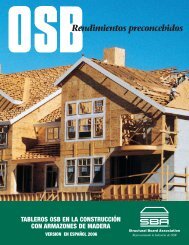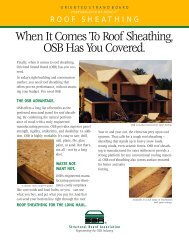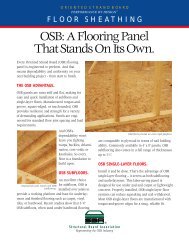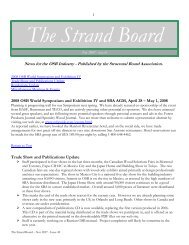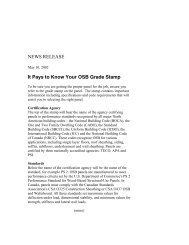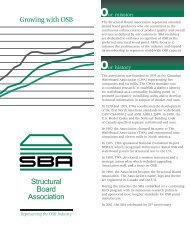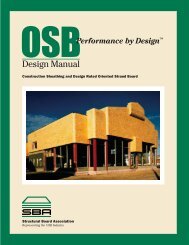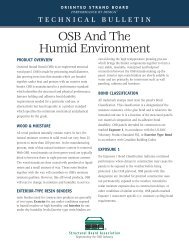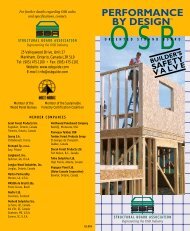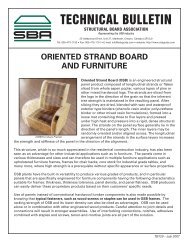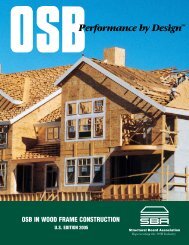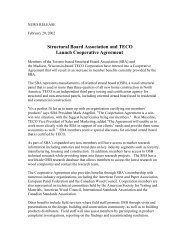Generic OSB Material Safety Data Sheet (TB115) - OSBGuide
Generic OSB Material Safety Data Sheet (TB115) - OSBGuide
Generic OSB Material Safety Data Sheet (TB115) - OSBGuide
Create successful ePaper yourself
Turn your PDF publications into a flip-book with our unique Google optimized e-Paper software.
TECHNICAL BULLETIN<br />
STRUCTURAL BOARD ASSOCIATION<br />
Representing the <strong>OSB</strong> Industry<br />
25 Valleywood Drive, Unit 27, Markham, Ontario, Canada L3R 5L9<br />
Tel: 905-475-1100 • Fax: 905-475-1101 • E-mail: info@osbguide.com • website: http://www.osbguide.com<br />
GENERIC ORIENTED STRAND BOARD<br />
MATERIAL SAFETY DATA SHEET<br />
PRODUCT IDENTIFICATION<br />
Product Name: Oriented Strand Board<br />
Synonyms: <strong>OSB</strong>, Waferboard, Rim Board, Web Stock, Proprietary Brand Names<br />
Note: Proprietary products may have slightly different ingredients or characteristics. Please check with manufacturer.<br />
HAZARDOUS INGREDIENTS<br />
Principal Hazardous Component Quantity Unit ACGIH TLV OSHA PEL 1<br />
(Common Name or Chemical) (Percent) TWA STEL TWA STEL<br />
Wood 85 - 97<br />
Softwood or Hardwood Total Dust (mg/m 3 ) 15 2 10 3<br />
Wood Dust - Not Preservative Treated:<br />
Inhalable - Western Red Cedar (mg/m 3 ) 0.5 none<br />
Inhalable - All Other Species (mg/m 3 ) 1 none<br />
Resin Solids:<br />
- Phenol Formaldehyde 4 0 - 15 ppm 0.3 5 none 0.75 2<br />
- Polymeric Diphenylmethane Diisocyanate 6 0 - 15 ppm none none none none<br />
Paraffin Wax 0 - 2 (mg/m 3 ) 2 none 2 none<br />
Notes:<br />
1. Values for State PEL (or Province OEL) may be more restrictive.<br />
2. Respirable fraction is limited to 5 mg/m 3 .<br />
3. Recommended exposure limits based on 1989 OSHA PELs: TWA 5 mg/m 3 and STEL 10 mg/m 3 for all<br />
softwoods and hardwoods, except western red cedar; TWA 2.5 mg/m 3 for western red cedar.<br />
4. Product contains less than 0.05% free formaldehyde (CAS RN 50-00-0). Phenol formaldehyde resin is<br />
used in the surface material and/or centre material.<br />
5. Ceiling value.<br />
6. This ingredient is the polymerized form of MDI binder (CAS RN 101-68-8). There are no detectable MDI<br />
monomers in the product as purchased. MDI binder is generally used in the centre material only.<br />
PHYSICAL AND CHEMICAL CHARACTERISTICS<br />
Boiling point (degrees Centigrade) n/a<br />
Specific gravity (water = 1.0) 0.5 - 0.7<br />
Percent volatile (by volume) 0<br />
Evaporation rate<br />
n/a<br />
Vapour pressure (mm of Hg)<br />
n/a<br />
Vapour density<br />
n/a<br />
Solubility in Water (% by weight) < 0.1%<br />
Appearance and Odour - brown panel consisting of a<br />
ligno-cellulosic matrix of interlocking wood fibres with<br />
slight aromatic odour (stronger when wet). The wood<br />
component may consist of the following species: alder,<br />
aspen, beech, birch, cottonwood, eastern red cedar, fir,<br />
gum, hemlock, hickory, maple, oak, pecan, pine, poplar,<br />
spruce, yellow cypress, walnut, and/or western red cedar.<br />
FIRE AND EXPLOSION DATA<br />
Flashpoint<br />
n/a<br />
Flammable Limits Lower n/a Upper n/a<br />
Fire Extinguishing Media Water, CO 2 , sand<br />
Auto Ignition Temperature Variable, typically 400-500 ˚F<br />
(200-260 ˚C)<br />
NFPA Rating (scale 0-4) Health =1; Fire=1;<br />
Reactivity=0<br />
Normal Fire-Fighting Procedures Equipment:<br />
Determined by surrounding fire. Use a water spray to wet<br />
down panels and any dust to prevent ignition. Remove<br />
burned material to open area after fire is extinguished.<br />
<strong>TB115</strong> – July 2005
Usual Fire or Explosion Hazard: Fine panel dust in an<br />
airborne concentration greater than 40 g/m 3 of air may<br />
explode if the dust cloud contacts a source of ignition.<br />
REACTIVITY DATA<br />
It is a stable product, however excess moisture conditions<br />
and open flame should be avoided. It is incompatible with<br />
oxidizing agents and drying oil. Good housekeeping procedures<br />
and routine disposal of panel dust is suggested. When<br />
burned it releases carbon monoxide, polycyclic aromatic<br />
hydrocarbons, carbon dioxide, aldehydes and other toxic<br />
fumes and gases. Hazardous polymerization will not occur.<br />
HEALTH HAZARDS<br />
Sign and Symptoms of Exposure<br />
1. Acute Overexposure: Panel dust may be a mechanical<br />
irritant to eyes. Excessive concentration may cause<br />
deposit in nasal passages resulting in rhinorrhea, dry<br />
cough, wheezing, sinusitis.<br />
2. Chronic Overexposure: Wood dust, depending on<br />
species, may cause dermatitis on prolonged, repetitive<br />
contact; may cause respiratory sensitisation and/or irritation.<br />
Prolonged exposure to wood dust has been reported<br />
by some observers to be associated with nasal cancer.<br />
IARC classifies wood dust as a Group 1 - carcinogen to<br />
humans. This classification is based on IARC's evaluation<br />
of increased risk in the occurrence of adeno-carcinomas of<br />
the nasal cavities and paranasal sinuses associated with<br />
the exposure to wood dust. IARC did not find sufficient<br />
evidence to associate cancers of the oropharynx,<br />
hypopharynx, lung, lymphatic and hematopoietic systems,<br />
stomach, colon, or rectum with exposure to wood dust.<br />
Note: These products are manufactured using a phenolformaldehyde<br />
thermoset resin and/or polyurethane<br />
binder. Maximum indoor formaldehyde levels associated<br />
with freshly manufactured panels are similar to outdoor<br />
background levels in urban areas (less than 0.1 ppm) and<br />
levels decrease through time as the panels age.<br />
Medical Conditions Generally Aggravated by Exposure:<br />
Individuals with predisposing respiratory disease -<br />
asthma, chronic bronchitis - may have difficulty working<br />
around airborne particulates including dust.<br />
Product Listed as Carcinogen - Formaldehyde<br />
NTP Yes - Reasonably anticipated to be a human carcinogen<br />
IARC Monographs Yes Group 1 - Carcinogenic to humans<br />
OSHA No - Regulated formaldehyde gas, potential<br />
carcinogen for exposures exceeding 0.5 ppm<br />
Formaldehyde has been classified as a known carcinogen<br />
or probable carcinogen by NTP, IARC, and OSHA. A working<br />
group of IARC has determined that there is sufficient<br />
evidence that formaldehyde causes nasopharyngeal cancer<br />
in humans, a rare form of cancer in developed countries.<br />
Product Listed as Carcinogen - Wood Dust<br />
NTP Yes - Known to be a human carcinogen<br />
IARC Monographs Yes Group 1 - Carcinogenic to humans<br />
OSHA No<br />
SPECIAL PROTECTION INFORMATION<br />
Respiratory Protection: NIOSH approved dust respirator<br />
recommended under dusty conditions.<br />
Ventilation: Local exhaust- Panel dust should be collected<br />
at source, so that exposure limits are met.<br />
Protective Gloves: Leather, cloth or canvas recommended<br />
to minimize slivers or irritation when handling.<br />
Eye Protection: <strong>Safety</strong> glasses or goggles recommended<br />
when machining.<br />
Other Protective Clothing or Equipment: Follow<br />
good hygiene and housekeeping practices. Clean up<br />
areas where dust settles to avoid excessive accumulation<br />
of this combustible material. Minimize blowdown or other<br />
practices generating high dust concentrations.<br />
EMERGENCY AND FIRST AID PROCEDURES<br />
1. Inhalation: Remove to fresh air. If persistent irritation,<br />
severe coughing, breathing difficulties or rash occur, seek<br />
medical advice. (Primary route of exposure is inhalation).<br />
2. Eyes: Panel dust may mechanically irritate the eye,<br />
resulting in redness or watering. Flush with water to<br />
remove dust particles. If irritation persists, seek medical<br />
attention.<br />
3. Skin: Various species of wood dust can elicit allergic<br />
contact dermatitis in sensitized individuals after repetitive<br />
contact. If a rash, or persistent irritation or dermatitis<br />
occurs, seek medical advice before working where panel<br />
dust is present.<br />
4. Ingestion: n/a<br />
SPECIAL PRECAUTIONS AND SPILL/LEAK<br />
PROCEDURES<br />
Precautions to be taken in Handling and Storage:<br />
No special handling precautions are required. Panels are<br />
combustible. Keep in cool, dry place away from open<br />
flame and other sources of ignition.<br />
Other Precautions: If this product is used in a process<br />
which generates dust levels in excess of the allowable<br />
exposure limit(s) for wood dust, a NIOSH approved dust<br />
respirator and goggles should be worn.<br />
Due to the explosive potential of wood dust when suspended<br />
in air, precautions should be taken to prevent sparks or<br />
other ignition sources in ventilation systems. Use of totally<br />
enclosed motors is recommended (or may be warranted) if<br />
process generates excessive levels of wood dust.
Steps to be taken in Case <strong>Material</strong> is Released or<br />
Spilled: Not applicable for product in purchased form.<br />
Panel dust may be vacuumed or shovelled for recovery or<br />
disposal. Avoid dusting conditions. Provide good ventilation<br />
where dusting is possible. Use NIOSH approved dust<br />
respirator and goggles where ventilation is not possible.<br />
Waste Disposal Methods: If disposed or discarded in its<br />
purchased form, incineration is preferable. Dry land disposal<br />
may be acceptable. It is however the user's responsibility<br />
to determine at time of disposal whether the product<br />
meets federal, state, provincial or local regulations.<br />
GLOSSARY<br />
ACGIH<br />
C<br />
CAS RN<br />
F<br />
IARC<br />
mg/m 3<br />
n/a<br />
NFPA<br />
NIOSH<br />
NTP<br />
OEL<br />
OSHA<br />
PEL<br />
ppm<br />
STEL<br />
TLV<br />
TWA<br />
American Conference of Governmental Industrial Hygienists<br />
degree Centigrade<br />
Chemical Abstracts Service Registry Number<br />
(American Chemical Society)<br />
degree Fahrenheit<br />
International Agency for Research on Cancer<br />
milligrams per cubic meter of air<br />
not applicable<br />
National Fire Protection Association (US)<br />
National Institute of Occupational <strong>Safety</strong> and Health (US)<br />
National Toxicology Program (US)<br />
occupational exposure limit<br />
Occupational <strong>Safety</strong> and Health Administration (US)<br />
permissible exposure level<br />
parts per million in air<br />
short term exposure limit (15 minutes)<br />
threshold limit value<br />
8 hour time weighted average<br />
Important: The information and data herein are believed<br />
to be accurate and have been compiled from sources<br />
believed to be reliable. SBA makes no warranty, express or<br />
implied, concerning the accuracy or completeness of the<br />
information and data herein and will not be liable for claims<br />
relating to any party's use of a reliance on the information<br />
and data contained herein. It is expected by SBA that the<br />
user of this information will confirm its accuracy and<br />
completeness with the supplier and/or manufacturer of the<br />
oriented strand board or waferboard product being<br />
purchased and/or used.



